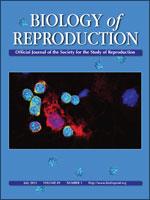There is no distinct explanation of the mechanism for the prepartal prostaglandin F2alpha (PGF2alpha) increase in pregnant dogs. Although the PGF2alpha-synthase (PGFS [AKR1C3]) mRNA expression and localization profiles have been previously investigated in canine utero/placental compartments, the availability and biochemical activity of the PGFS (AKR1C3) protein remain unknown. In order to better understand the regulation of canine uterine PGF2alpha availability and eventual prepartum release in luteolytic amounts in dogs, canine-specific PGFS (AKR1C3) and 15-hydroxyprostaglandin dehydrogenase (HPGD) antibodies were generated and used to characterize the expression, cellular localization, and biochemical properties of PGFS (AKR1C3) and HPGD in the utero/placental compartments and corpus luteum throughout pregnancy and at prepartum luteolysis. PGFS (AKR1C3) expression was weak or absent in luteal samples. Uterine PGFS (AKR1C3) was up-regulated postimplantation and declined prepartum. The utero/placental expression of PGFS (AKR1C3) was identified in the superficial uterine glands throughout gestation and in the trophoblast cells within the feto-maternal contact zone during placentation, suggesting a possible role for PGFS (AKR1C3) in the trophoblast invasion. Utero-placental HPGD was up-regulated until postimplantation, lower at midgestation, and greatly suppressed at prepartum. Expression was routinely identified in the endometrial surface and glandular epithelia, and positive signals were also observed in the trophoblast cells at the feto-maternal contact zone. The biochemical activity of recombinant PGFS (AKR1C3) and HPGD was confirmed after its expression in a heterologous system. The colocalization of HPGD with PGFS (AKR1C3) expression suggests a modulatory role for HPGD as a gatekeeper of the supply of prostaglandin in the pregnant canine uterus.
How to translate text using browser tools
15 May 2013
Biosynthesis and Degradation of Canine Placental Prostaglandins: Prepartum Changes in Expression and Function of Prostaglandin F2alpha-Synthase (PGFS, AKR1C3) and 15-Hydroxyprostaglandin Dehydrogenase (HPGD)
Aykut Gram,
Urs Büchler,
Alois Boos,
Bernd Hoffmann,
Mariusz P. Kowalewski
ACCESS THE FULL ARTICLE

Biology of Reproduction
Vol. 89 • No. 1
July 2013
Vol. 89 • No. 1
July 2013
carnivore reproduction
comparative reproduction
female reproductive tract
gene expression
placenta




